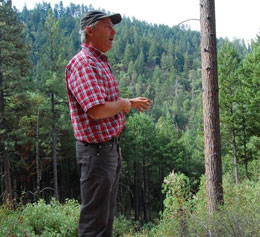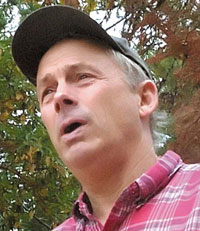 |
|||||
| Forest Resources Home | News | Make a Gift | UW Alumni | |||||
|
September 2010 | Return to issue home
Marty Main, Letting the Land Do the Talking
For nearly 30 years, Marty Main, ’96, and his wife, Peggy, have operated Small Woodland Services, Inc. (SWS), a small scale forestry company in southwest Oregon. Now based in Medford, the company provides full spectrum services, from planting and restoration, to planning, fuels reduction and harvest. Main’s interlude at SFR in the 1990s for a Master of Forest Resources in silviculture was, he says, "a great mid-career educational experience, in which I interacted with some truly outstanding faculty and professionals." Since receiving his degree, he has also served as the contract consulting forester for the City of Ashland, Ore., where he has worked on management plans for wildfire protection, water quality, forest health and wildlife, and has been active in community outreach and education projects in collaboration with the USDA Forest Service, The Nature Conservancy, Southern Oregon University and other organizations. But whoever the audience and wherever the forest, Main's approach has been the same, "I've always wanted to let the land do the talking. That's what's been missing." The initial goal in starting SWS was to diversify involvement in the forest—to shift the focus of management to forests owned by small landowners. Since that time, in his work with small landowners, Main has found they've often been less constrained or motivated by what tends to drive industrial and public forest management—profit and regulation. "For the most part," says Main, “small landowners manage forests according to personal conviction." He helps them gain a better understanding of their forests and accomplish their goals, whether they are managing for economic return, fire hazard reduction, forest diversification or the development of an aesthetically pleasing home site. More often, it has been an integration of multiple goals—an emerging characteristic of forest and resource management on other ownerships as well. Over the years SWS, with a core group of one to six employees, has worked with hundreds of landowners, and numerous municipalities and agencies across southwest Oregon. Most of the work is local and year-round, providing short commutes and economic stability for the employees. Main’s forestry work on City of Ashland forestlands in the Ashland watershed provides a set of challenges that requires exceptional communications and organizational skills. Says Main, "Ashland’s setting—surrounded by 14,500 acres of the Rogue River-Siskiyou National Forest in the Ashland watershed and another 1,000 contiguous forest acres owned by the City, as well as several thousand acres of private, non-industrial forestland—means that partnerships with community groups and agencies like the Forest Service are essential." The surrounding forest provides the city's drinking water and a scenic and recreational backdrop; approximately 1,400 homes in and around Ashland are located in a wildland urban interface mapped by Main for wildfire hazard. Main has worked over the years on developing and implementing management plans to reduce fire danger in the watershed and wildfire zones. In addition, the watershed contains a large forest ecosystem containing values that include late successional forests and high populations of older forest–dependent species such as fishers and northern spotted owls. It is also a highly diverse ecosystem, ranging from 2,000-7,000 feet elevation and 20-60 inches of annual precipitation in just nine linear miles. Recent projects include Ashland Forest Resiliency (AFR), a unique partnership among the City of Ashland, the U.S. Forest Service, The Nature Conservancy and the Lomakatsi Restoration Project, a nonprofit contracting firm providing workforce capacity and training in projects focusing on restoration objectives. The AFR project, under a unique Stewardship Agreement, will implement ecologically sensitive forest and resource management to improve the longterm resiliency of the forest ecosystem, while minimizing the potential for high severity disturbance like wildfire. Approved by the U.S. Forest Service in October 2009, AFR involves thinning and prescribed burning on 7,600 acres of Forest Service land to reduce the risk of wildfire while maintaining watershed, late-successional and other important values.
But perhaps the land talks best on the 120-acre forest the Mains own and manage. The forest that once held an average of some 2,000 stems per acre has been greatly thinned, both commercially and noncommercially, to encourage development of mature conifers. While some hardwoods and brush have been removed to reduce fuels and favor conifers, larger oak and madrone have flourished where their competition has been reduced. As much of the thinned material as possible is used—for firewood, posts and poles, milled dimensional lumber and logs. Prescribed underburning has also been used, restoring that critical functional process to forest stand development while encouraging a closer resemblance to the open pine forest that once dominated the site. Slowly, a more uneven-aged forest with a greater diversity of species and stand structures has been developed, while reducing the potential for wildfire. A recent Conservation Innovation Grant awarded in conjunction with Oregon State University is using the Main property to provide an example of how private parcels can be managed to encourage older forest values. However, the most important part of his work, says Main, "may be the personal connection that it allows a forest landowner to make with their land—one of being a caretaker or a steward of that land. It has been really exciting over the years to be a part of fostering that connection, regardless of individual or ownership. In the process, I’ve had the good fortune to work with a lot of great people in interacting with a wide diversity of forests in southwestern Oregon."Photo by Ashland Daily Tidings September 2010 | Return to issue home | |||||
|
|||||

